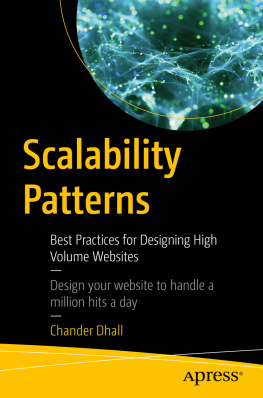Chander Dhall - Scalability Patterns: Best Practices for Designing High Volume Websites
Here you can read online Chander Dhall - Scalability Patterns: Best Practices for Designing High Volume Websites full text of the book (entire story) in english for free. Download pdf and epub, get meaning, cover and reviews about this ebook. year: 2018, publisher: Apress, genre: Computer. Description of the work, (preface) as well as reviews are available. Best literature library LitArk.com created for fans of good reading and offers a wide selection of genres:
Romance novel
Science fiction
Adventure
Detective
Science
History
Home and family
Prose
Art
Politics
Computer
Non-fiction
Religion
Business
Children
Humor
Choose a favorite category and find really read worthwhile books. Enjoy immersion in the world of imagination, feel the emotions of the characters or learn something new for yourself, make an fascinating discovery.
- Book:Scalability Patterns: Best Practices for Designing High Volume Websites
- Author:
- Publisher:Apress
- Genre:
- Year:2018
- Rating:3 / 5
- Favourites:Add to favourites
- Your mark:
Scalability Patterns: Best Practices for Designing High Volume Websites: summary, description and annotation
We offer to read an annotation, description, summary or preface (depends on what the author of the book "Scalability Patterns: Best Practices for Designing High Volume Websites" wrote himself). If you haven't found the necessary information about the book — write in the comments, we will try to find it.
In this book, the CEO of Cazton, Inc. and internationally-acclaimed speaker, Chander Dhall, demonstrates current website design scalability patterns and takes a pragmatic approach to explaining their pros and cons to show you how to select the appropriate pattern for your site. He then tests the patterns by deliberately forcing them to fail and exposing potential flaws before discussing how to design the optimal pattern to match your scale requirements. The author explains the use of polyglot programming and how to match the right patterns to your business needs. He also details several No-SQL patterns and explains the fundamentals of different paradigms of No-SQL by showing complementary strategies of using them along with relational databases to achieve the best results. He also teaches how to make the scalability pattern work with a real-world microservices pattern.
With the proliferation of countless electronic devices and the ever growing number of Internet users, the scalability of websites has become an increasingly important challenge. Scalability, even though highly coveted, may not be so easy to achieve. Think that you cant attain responsiveness along with scalability? Chander Dhall will demonstrate that, in fact, they go hand in hand.
What Youll Learn
Architect and develop applications so that they are easy to scale.
Learn different scaling and partitioning options and the combinations.
Learn techniques to speed up responsiveness.
Deep dive into caching, column-family databases, document databases, search engines and RDBMS.
Learn scalability and responsiveness concepts that are usually ignored.
Effectively balance scalability, performance, responsiveness, and availability while minimizing downtime.
Who This Book Is For
Executives (CXOs), software architects , developers, and IT Pros
Chander Dhall: author's other books
Who wrote Scalability Patterns: Best Practices for Designing High Volume Websites? Find out the surname, the name of the author of the book and a list of all author's works by series.















